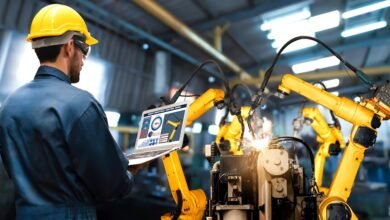The Future of Industrial IoT: Predictions for German Manufacturing
The Industrial Internet of Things (IIoT) represents the next evolutionary leap in manufacturing, and Germany—the birthplace of Industry 4.0—is leading the charge.

The Industrial Internet of Things (IIoT) represents the next evolutionary leap in manufacturing, and Germany—the birthplace of Industry 4.0—is leading the charge. By embedding smart sensors, AI-driven analytics, and autonomous systems into production environments, German manufacturers are achieving unprecedented levels of efficiency, flexibility, and sustainability.
This in-depth analysis explores the key IIoT trends shaping German manufacturing, backed by real-world case studies, statistical insights, and expert predictions. We’ll examine how 5G, digital twins, collaborative robotics, and edge computing are redefining production while addressing critical challenges like cybersecurity, legacy system integration, and workforce transformation.
For executives, plant managers, and Industry 4.0 strategists, understanding these developments is crucial to maintaining Germany’s competitive edge in smart manufacturing.
The Current State of IIoT Adoption in Germany
Market Penetration and Industry Leaders
Germany’s manufacturing sector has embraced IIoT faster than most European counterparts:
- 56% of industrial firms have deployed IIoT solutions (VDMA, 2023)
- Automotive (BMW, Volkswagen, Bosch) leads in predictive maintenance and smart assembly lines
- Industrial machinery (Siemens, Trumpf) uses digital twins and AI optimization
- Chemical/pharmaceutical (BASF, Bayer) applies IIoT for energy efficiency and batch monitoring
Key Drivers of Adoption
- Cost Reduction—IIoT minimizes unplanned downtime (saving up to €200,000/hour in auto plants)
- Quality Control—Real-time defect detection improves yield rates by 5-10%
- Regulatory Push—EU mandates like the Carbon Border Adjustment Mechanism (CBAM) incentivize smart energy use
Persistent Challenges
Despite progress, bottlenecks remain:
| Challenge | Impact | Mitigation Strategies |
|---|---|---|
| Legacy machine integration | 60% of factories use equipment >15 years old | Retrofit kits with IoT gateways |
| Cybersecurity vulnerabilities | 47% of German manufacturers experienced IoT breaches in 2023 | Zero-trust architectures, AI threat detection |
| Workforce skills gap | 78% of companies report shortage of IIoT talent | Government-funded upskilling programs (e.g., “Zukunft der Arbeit” initiative) |
7 Transformative IIoT Predictions for German Manufacturing
1. AI and Edge Computing: The Brains of the Smart Factory
Deep Learning Applications:
- Predictive Maintenance—Vibration sensors + AI models predict bearing failures 3 weeks in advance (Siemens)
- Computer Vision QC—BMW’s neural networks detect paint defects with 99.4% accuracy
- Generative AI—Optimizes production schedules by analyzing 10,000+ variables
Edge Computing Breakthroughs:
- Latency Reduction—Local data processing cuts response times to < ms (vs. ms in cloud)
- Bandwidth Savings—Filters 90% of irrelevant sensor data before transmission
- Autonomous Decision-Making—KUKA robots self-adjust workflows without cloud dependency
Case Study: ZF Friedrichshafen reduced transmission failures by 40% using edge-based vibration analysis.
2. Digital Twins: From Concept to Core Infrastructure
Implementation Levels:
| Maturity Stage | Capabilities | Adoption Rate |
|---|---|---|
| Basic Monitoring | Real-time equipment dashboards | 32% of firms |
| Predictive Simulation | Failure scenario modeling | 18% |
| Autonomous Optimization | Self-adjusting production parameters | 5% (pioneers like Siemens) |
Future Applications:
- Supply Chain Digital Twins—Simulate global logistics disruptions
- Product Lifecycle Twins—Track assets from factory to recycling
- Human Digital Twins—Optimize worker safety through biomechanical modeling
Data Point: Digital twin users report 30% faster time-to-market (PwC).
3. 5G and Time-Sensitive Networking (TSN)
Technical Advantages:
- Ultra-Reliable Low Latency Communication (URLLC) – Enables sub-millisecond control loops
- Network Slicing—Dedicated bandwidth for critical operations
- Massive Machine-Type Communication (mMTC) – Supports 500,000 devices/km²
Deployment Models:
- Campus Networks—Bosch’s Stuttgart plant operates private 5G at 3.7-3.8 GHz
- Hybrid LTE/5G—Transition solutions for brownfield sites
Impact: 5G-enabled AGVs improve warehouse throughput by 22% (Fraunhofer IPT).
4. Cybersecurity: The Growing Battlefield
Emerging Threats:
- AI-Powered Malware—Adapts to bypass traditional defenses
- Supply Chain Attacks—Compromised vendor software updates
- Ransomware-as-a-Service—Targeting mid-sized manufacturers
German Defense Strategies:
- TÜV-certified IIoT devices—mandatory security audits
- Quantum Cryptography—Deutsche Telekom testing QKD networks
- AI SOCs—Continuous anomaly detection (e.g., SAP’s AI cybersecurity center)
Regulation Update: The EU Cyber Resilience Act (2024) imposes strict IoT security requirements.
5. Sustainable Manufacturing Through IIoT
Energy Optimization:
- Dynamic Load Shifting—AI aligns production with renewable energy availability
- Compressed Air Leak Detection—Saves €25,000/year per factory (Festo)
- Heat Recovery Systems—IIoT redirects waste heat to other processes
Circular Economy Enablement:
- Smart Material Passports—blockchain-tracked recyclability data
- Remanufacturing 4.0—Robotics disassemble end-of-life products
Industry Benchmark: Schaeffler’s smart factories reduced CO₂ by 12% annually via IIoT.
6. Human-Machine Collaboration Redefined
Cobot Advancements:
- Force-Limited Robotics—KUKA’s LBR iisy operates safely alongside workers
- AI Gesture Control—Workers direct machines via hand motions
Augmented Workforce:
- AR Maintenance Guides—Overlay repair instructions on equipment (Daimler)
- Exoskeletons—IoT-connected suits reduce fatigue injuries by 27%
Productivity Gain: Volkswagen’s cobot-assisted assembly lines saw 15% faster cycle times.
7. Supply Chain Immune Systems
IIoT-Enabled Resilience:
- Autonomous Freight Tracking—SAP’s blockchain logistics monitors shipments in real-time
- Predictive Supplier Risk—AI analyzes 150+ risk indicators
- Smart Contracts—Automate payments upon IoT-verified delivery
Post-Crisis Data: Companies with IIoT supply chains had 35% lower pandemic disruptions (McKinsey).
Overcoming Implementation Barriers
Legacy System Integration Strategies
- OPC UA Gateways—Bridge old PLCs to modern IoT platforms
- Retrofit Sensor Kits—Non-invasive vibration/temperature monitoring
- Digital Shadowing—Create virtual models of analog machines
Cost-Benefit Analysis Framework
| Investment Area | Typical ROI Timeline |
|---|---|
| Predictive Maintenance | 8-14 months |
| Energy Monitoring | 6-12 months |
| Digital Twins | 18-36 months |
Workforce Transformation Roadmap
- DUAL EDUCATION SYSTEM 4.0—Updated mechatronics curricula
- VR Training Simulators—Hands-on IIoT experience without downtime
- Gamified Upskilling—Bosch’s “Factory Heroes” training platform
Strategic Recommendations for German Manufacturers
- Start with High-Impact Use Cases – Prioritize predictive maintenance or energy optimization
- Adopt Modular Architecture—Ensure scalability with platforms like MindSphere
- Partner with Research Institutes—Leverage Fraunhofer’s IIoT testbeds
- Participate in GAIA-X—contribute to Europe’s sovereign data infrastructure
Conclusion: Securing Germany’s Industrial Future
The convergence of IIoT, AI, and 5G is creating a new paradigm for German manufacturing—one where factories self-optimize, supply chains self-heal, and sustainability becomes automated. While challenges around cybersecurity and legacy systems persist, the companies that embrace this transformation will dominate global markets.
Call to Action:
- Download our IIoT Implementation Blueprint (40-page playbook with ROI calculators)
- Schedule a Smart Factory Assessment with our Industry 4.0 specialists
- Join our Executive Roundtable on IIoT strategies (Next session: Nov 15, Berlin)











